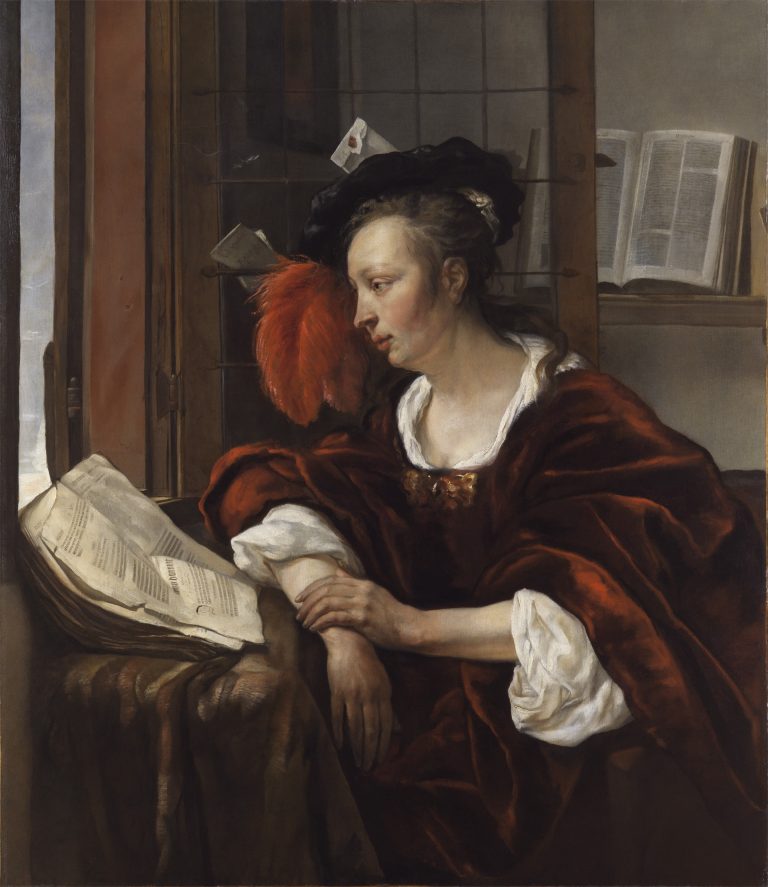Gabriel Metsu, like a number of other Dutch artists renowned for their domestic scenes and high-life interiors, began his career painting an entirely different type of subject. Metsu initially painted subjects drawn from the bible or mythology, much as did Nicolaes Maes (1634–93) and Johannes Vermeer (1632–75). Another artist who shifted from one genre to another was Pieter de Hooch (1629–84), who depicted guardroom scenes before switching to domestic subjects. For none of these young masters did the change from one subject type to another occur overnight. Their thematic and stylistic evolution was an ongoing process as they learned to balance their artistic aspirations, inherent strengths, and the changing character of the art market. Vermeer’s Procuress of 1656 is a case in point, for it relates both to genre and history painting traditions. Even though this painting appears, at first glance, to be a merry company scene, it has thematic connections to the parable of the Prodigal Son.1 Similarly, Woman Reading a Book by a Window, which dates to the artist’s late Leiden period, about 1653–54, is a transitional piece in Metsu’s career. While this large picture appears to be a scene drawn from daily life, it probably derives from a literary or allegorical source.
In this painting, Metsu has depicted a life-sized woman seated next to an open window. Leaning on a small table covered with a striped carpet, she stares out into the world as though contemplating an idea she has just taken from the text of the open book before her.2 Her distinctive wardrobe—a voluminous rusty-red cloak, loose-fitting white shirt, and black feathered beret—would have indicated to a seventeenth-century viewer that she was not a contemporary Dutch sitter, but a figure drawn from a different time and place. Metsu’s painting, in fact, calls to mind works by Ferdinand Bol (1616–80) from the early 1650s that depict attractive female figures in “antique” attire, which may best be described as half-length tronies (fig 1).3 An even closer comparison can be made with a painting dated 1652 by the Haarlem artist Salomon de Bray (1597–1664), which is a portrait historié of a woman probably in the guise of Semiramis (fig 2).4 The similarities in costume between the women in Metsu’s and De Bray’s paintings are striking; however, the large book makes it unlikely that Metsu’s sitter also depicts the Assyrian queen.5
Rather than a half-length tronie or a portrait historié, Metsu’s woman probably represents an allegorical figure. Seventeenth-century artists frequently modernized traditional allegories by placing them in contemporary interiors, as, for example, did Jan Miense Molenaer (1610–68) in A Lady at Her Toilet (Lady World) and Vermeer in Allegory of Faith.6 When painting allegorical figures, Dutch artists generally consulted Cesare Ripa’s Iconologia (1593), an influential emblem book that explains how abstract concepts, such as virtues and vices, could be personified. Ripa published the first edition of his seminal work in Italian in Rome in 1593, but Metsu was likely familiar with the Dutch edition, which had been translated by Dirck Pers in 1644. Ripa’s book describes and illustrates various female personifications with books, including Wisdom, Philosophy, Rhetoric, Eloquence, and Knowledge.7 Ripa, however, always includes additional attributes with these personifications, among them a birdcage or a torch, that are not to be found in Metsu’s painting.8 Hence, even though it seems probable that Metsu intended his female figure to be an allegorical personification of an abstract concept related to learning or knowledge, it is not yet possible to interpret exactly his intent.
Woman Reading a Book by a Window occupies a significant place in Metsu’s early artistic development. It is the earliest surviving painting in which the artist depicted a contemporary Dutch interior. Prior to this time, Metsu had painted only outdoor scenes and imaginary interiors of sandstone palaces, churches and brothels. Although this interior serves only as a backdrop to the figure, the setting is comparable to those depicted by other Leiden genre painters of the mid-seventeenth century. These generally focus on the left corner of a shallow room with the back wall running parallel to the picture plane and a window that allows natural light to illuminate the interior. Confident with what he had achieved in Woman Reading a Book by a Window, Metsu went a step further in A Moneylender Visited by a Weeping Woman (fig 3), which shows a larger and more elaborate interior.
Metsu signed this painting Gabriel/Metsu on a letter stuck in a window bar behind the woman’s head. It is only one of two works that the artist inscribed with his full name. The other painting, A Woman Giving Alms to a Boy, dates to 1657–59.9 Metsu usually signed his works Gmetsu (G and m in ligature) or G.Metsu.
